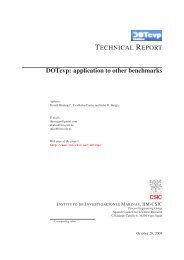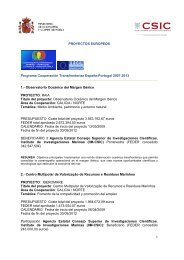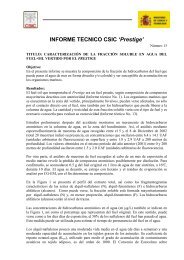Climate in Spain: Past, Present - Red Temática de CLIVAR-España
Climate in Spain: Past, Present - Red Temática de CLIVAR-España
Climate in Spain: Past, Present - Red Temática de CLIVAR-España
- No tags were found...
Create successful ePaper yourself
Turn your PDF publications into a flip-book with our unique Google optimized e-Paper software.
<strong>CLIVAR</strong> - Spa<strong>in</strong>EXECUTIVE SUMMARYFor over more than two <strong>de</strong>ca<strong>de</strong>s, the <strong>in</strong>ternational scientific community has been provid<strong>in</strong>gcompell<strong>in</strong>g evi<strong>de</strong>nce of the anthropogenic <strong>in</strong>fluence on global climate. The latest report (AR4) of theIntergovernmental Panel on <strong>Climate</strong> Change (IPCC) reiterates, forcefully, the importance of the impact thathumans are hav<strong>in</strong>g on climate and alerts about its possible consequences for the planet.This report by the <strong>CLIVAR</strong>-Spa<strong>in</strong> Thematic Network summarizes and assesses the available<strong>in</strong>formation on the physical aspects of the changes that have been observed <strong>in</strong> the climate of the IberianPen<strong>in</strong>sula (IP), both <strong>in</strong> current times and <strong>in</strong> the distant past, and tries to enhance our un<strong>de</strong>rstand<strong>in</strong>g of thosechanges <strong>in</strong> or<strong>de</strong>r to better predict the impacts of future changes.The <strong>Climate</strong> of the IP <strong>in</strong> the <strong>Past</strong>Studies of the evolution of climate <strong>in</strong> the past <strong>in</strong>dicate that the IP was <strong>in</strong>tensely affected by rapidclimatic changes (on time scales rang<strong>in</strong>g from <strong>de</strong>ca<strong>de</strong>s to a few hundred years) that were associated withlarge-scale variability patterns typical of the North Atlantic region. Some of these events, which took placedur<strong>in</strong>g the <strong>de</strong>glaciation (19000-11000 years BP), resulted <strong>in</strong> the most extreme climate conditions <strong>in</strong> terms ofcoldness and aridity, even exceed<strong>in</strong>g those of the last glacial maximum (some 23000 years ago). Dur<strong>in</strong>g thecurrent <strong>in</strong>terglacial period, known as Holocene, which spans the last 11700 years, numerous climateoscillations have been documented that entailed relatively mild temperature changes but that significantlyaltered the water balance of the IP, provid<strong>in</strong>g a historical perspective of recent climate changes.The Current <strong>Climate</strong> of the IP: ObservationsTemperature: The <strong>in</strong>strumental records of the 20 th century show a progressive <strong>in</strong>crease <strong>in</strong> temperaturethat has been particularly pronounced <strong>in</strong> the last three <strong>de</strong>ca<strong>de</strong>s (1975–2005), with a rate of warm<strong>in</strong>g close to0.5ºC/<strong>de</strong>ca<strong>de</strong> (50% higher than the Northern Hemisphere cont<strong>in</strong>ental average and almost three times as largeas the global average). When the entire 20 th century is consi<strong>de</strong>red, the warm<strong>in</strong>g has affected all seasonsevenly, but <strong>in</strong> the last 30 years the warm<strong>in</strong>g has been much more pronounced <strong>in</strong> spr<strong>in</strong>g and summer.Precipitation: Annual precipitation <strong>in</strong> the last three <strong>de</strong>ca<strong>de</strong>s has <strong>de</strong>creased significantly compared tothe <strong>de</strong>ca<strong>de</strong>s of the 60s and 70s, mostly due to ra<strong>in</strong>fall reductions <strong>in</strong> late w<strong>in</strong>ter. The current <strong>de</strong>ca<strong>de</strong> may havebeen the driest s<strong>in</strong>ce 1950. However, the strong <strong>in</strong>terannual variability and the lack of data extend<strong>in</strong>g to thebeg<strong>in</strong>n<strong>in</strong>g of the century preclu<strong>de</strong>s a conclusive statement as to whether precipitation has dim<strong>in</strong>ished to ahistorical m<strong>in</strong>imum. Overall, an anthropogenic signal <strong>in</strong> precipitation has not emerged <strong>in</strong> an unambiguousmanner above the natural background noise. In particular, the pronounced <strong>de</strong>crease <strong>in</strong> summer precipitationprojected by climate mo<strong>de</strong>ls for the end of the 21 st century is not yet apparent <strong>in</strong> observations.Mar<strong>in</strong>e Parameters: From 1985 to 2005, the sea surface temperature <strong>in</strong> the Bay of Biscay <strong>in</strong>creasedby 0.12ºC/<strong>de</strong>ca<strong>de</strong> <strong>in</strong> the southwest and by 0.35ºC/<strong>de</strong>ca<strong>de</strong> <strong>in</strong> the northwest, consistent with the average<strong>in</strong>crease of 0.19 ± 0.13ºC/<strong>de</strong>ca<strong>de</strong> estimated for the Northern Hemisphere from 1979 to 2005 (IPCC). Thiswarm<strong>in</strong>g has affected to the entire water column, with temperature rises dur<strong>in</strong>g the 90s between 0.15ºC and0.30 ºC/<strong>de</strong>ca<strong>de</strong> <strong>in</strong> the first 1000 meters. In the western Mediterranean bas<strong>in</strong>, a rise <strong>in</strong> temperature and sal<strong>in</strong>ity<strong>in</strong> <strong>de</strong>ep layers has been recor<strong>de</strong>d dur<strong>in</strong>g the second half of the 20 th century, as well as a rise <strong>in</strong> sal<strong>in</strong>ity at<strong>in</strong>termediate layers (~0.00013 psu/year). From 1967, a drop of 30% has been observed <strong>in</strong> the <strong>in</strong>tensity of theupwell<strong>in</strong>g at the Atlantic coast, which has <strong>de</strong>creased primary productivity and has slowed down the renewal ofcoastal waters.Sea Level: On the Atlantic coast, ti<strong>de</strong> gauges have recor<strong>de</strong>d a susta<strong>in</strong>ed sea level rise of around 1.4mm/year when the entire 20 th century is consi<strong>de</strong>red, and of more than 2 mm/year for the second half of thecentury. On the Mediterranean coast, on the other hand, the sea level trends observed dur<strong>in</strong>g the second half ofthe century are smaller or even negative. Evi<strong>de</strong>ntly, the atmospheric pressure, which has been abnormally high<strong>in</strong> this area between the 60s and the 90s, and the <strong>in</strong>crease <strong>in</strong> sal<strong>in</strong>ity have partly compensated for the steric sealevel rise observed on a global scale. Nevertheless, ti<strong>de</strong> gauge records <strong>in</strong> the western Mediterranean that spanthe entire 20 th century exhibit positive sea level trends of 1.2 mm/year.5















